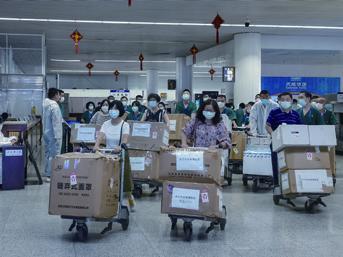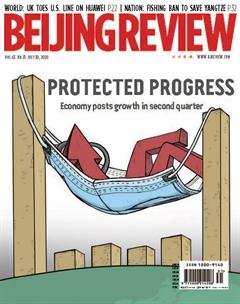Quick Response
By Li Fangfang

Xie Hui, a 31-year-old resident of Xinjiang Uygur Autonomous Region, northwest China, halted her daily commute between Urumqi, the capital city of Xinjiang, and her home in another city some 20 km away, since July 17 after the novel coronavirus disease (COVID-19) reemerged in the northwest region of China.
On July 15, a young woman became the first COVID-19 patient in Tianshan District in downtown Urumqi, ending Xinjiangs record of zero new locally transmitted infections for four months, the citys prevention and control task force announced a day later.
“Nobody would like to take the risk of getting infected,” Xie said.
As of July 23, there were 95 confirmed COVID-19 patients in Xinjiang, 93 of them in Urumqi, and 85 asymptomatic cases. A total of 3,346 close contacts of infected persons were under observation.
All the patients and asymptomatic carriers have been sent to the Xinjiang Uygur Autonomous Region Sixth Peoples Hospital, an infectious disease hospital with 800 beds. Under experts guidance, the hospital implements a "one person, one therapy" strategy to treat the patients.
When the virus reappeared in Xinjiang, the government responded quickly, Kurbanjan Samat, an Uygur photographer.
Mass testing began on July 17, and by July 22, Urumqi, a city of 3.5 million people, had completed nucleic acid tests for more than 1.6 million, according to the regional governments daily news briefi ng.
“Almost all of our doctors and nurses are administering the tests. I have been working 12-hour days recently,” a doctor surnamed Luo told Beijing Review.
Rui Baoling, head of the citys disease control and prevention center, said the center has implemented a pooled sampling method, which tests samples from fi ve people together.
“If any group is found positive, we redo the test for each individual,” Luo said.
Having been used in Wuhan and Beijing, the method has significantly improved the testing efficiency and capacity. “During the test, we pay special attention to registering accurate personal information,” Rui said.
Besides nucleic acid tests, IgG and IgM, two types of immunoglobulin tests, have also been carried out in Xinjiang for months.
The IgM antibody appears soon after infection, indicating the infection occurred recently. The IgG antibody appears two weeks after infection and stays for a long time. Double antibody tests can also be used to infallibly determine whether a person is infected. The double antibody test is suitable for those who show negative in a nucleic acid test but exhibit certain clinical symptoms.
Medical teams from other parts of China have been helping in Xinjiang. Ten such teams working with 1,600 local medical staff in 24 local test organizations were expected to test 600,000 people a day, according to the citys center for disease prevention and control.
Hubeis medical team arrived on July 18, bringing along equipment and reagents for nucleic acid detection. They helped transform a laboratory and started working immediately.
“They have been racing against time, and we respect them from the bottom of our hearts,” said Gong Haiyan, a doctor in the Fifth Hospital Affiliated to Xinjiang Medical University.
The team comprises 21 medical staff members from three hospitals in Wuhan, capital of Hubei. All of them have fi rsthand experience of COVID-19 testing. Earlier this year, Xinjiang sent three teams to support hospitals in Hubei when it was hit by the COVID-19 epidemic.

